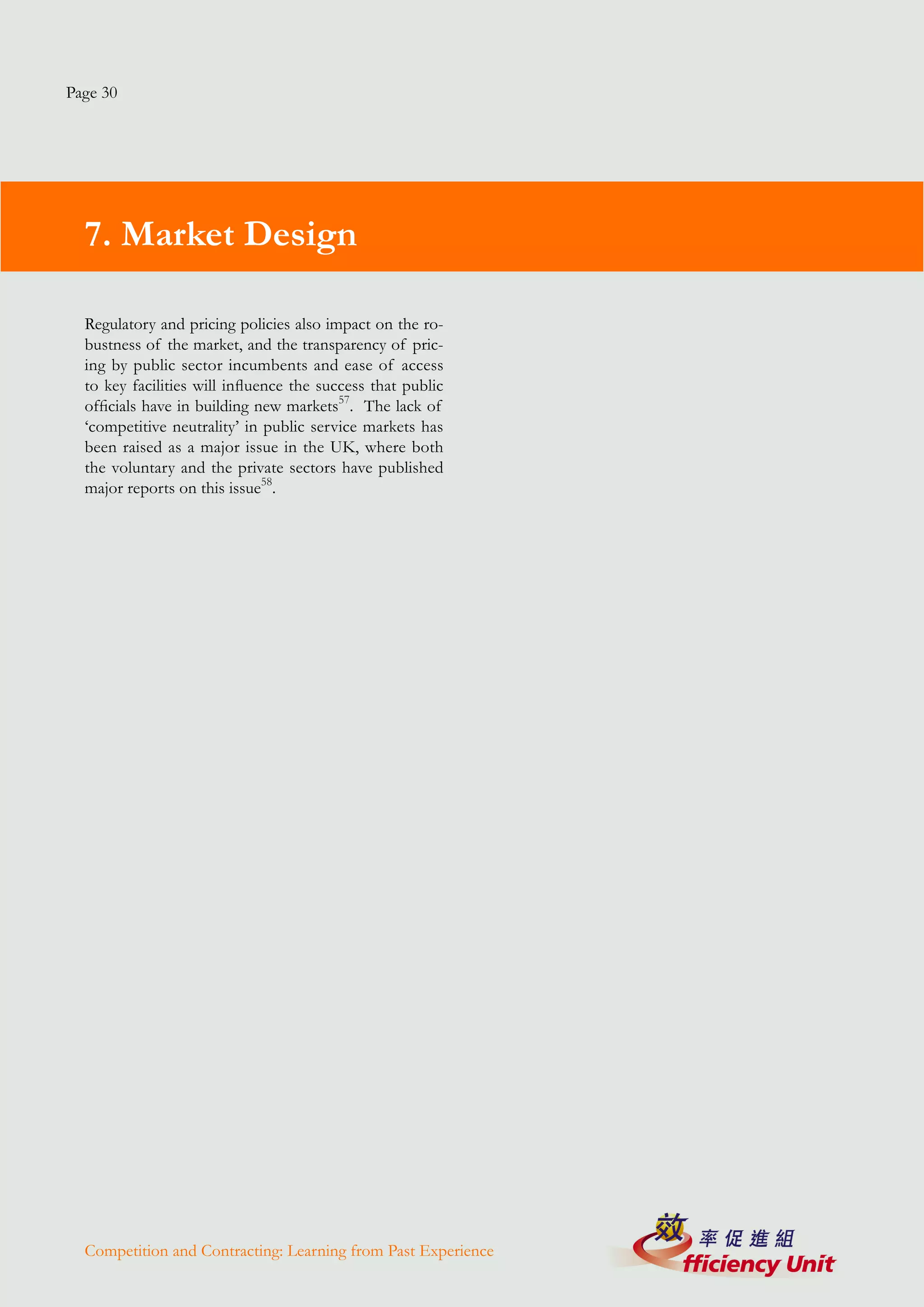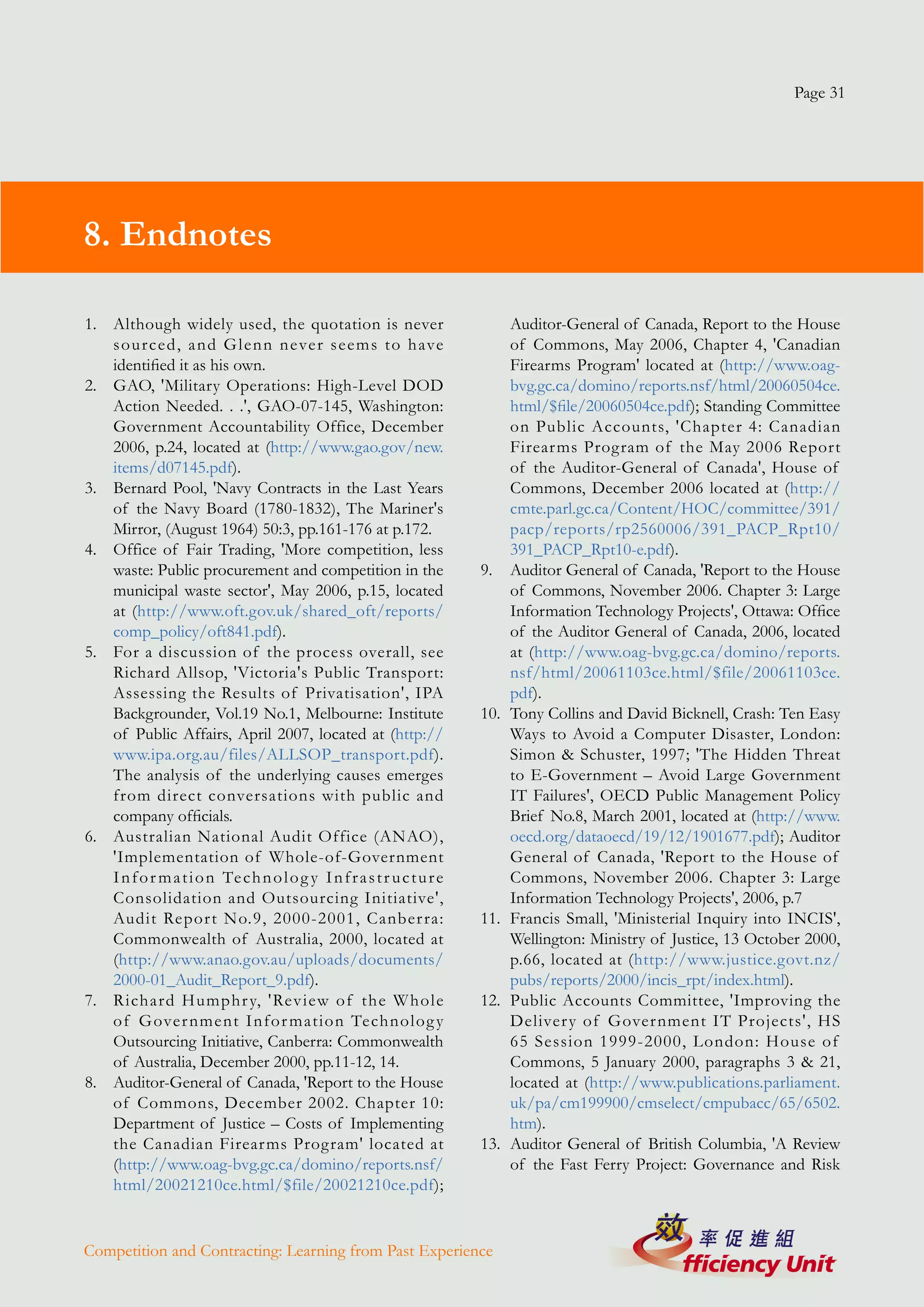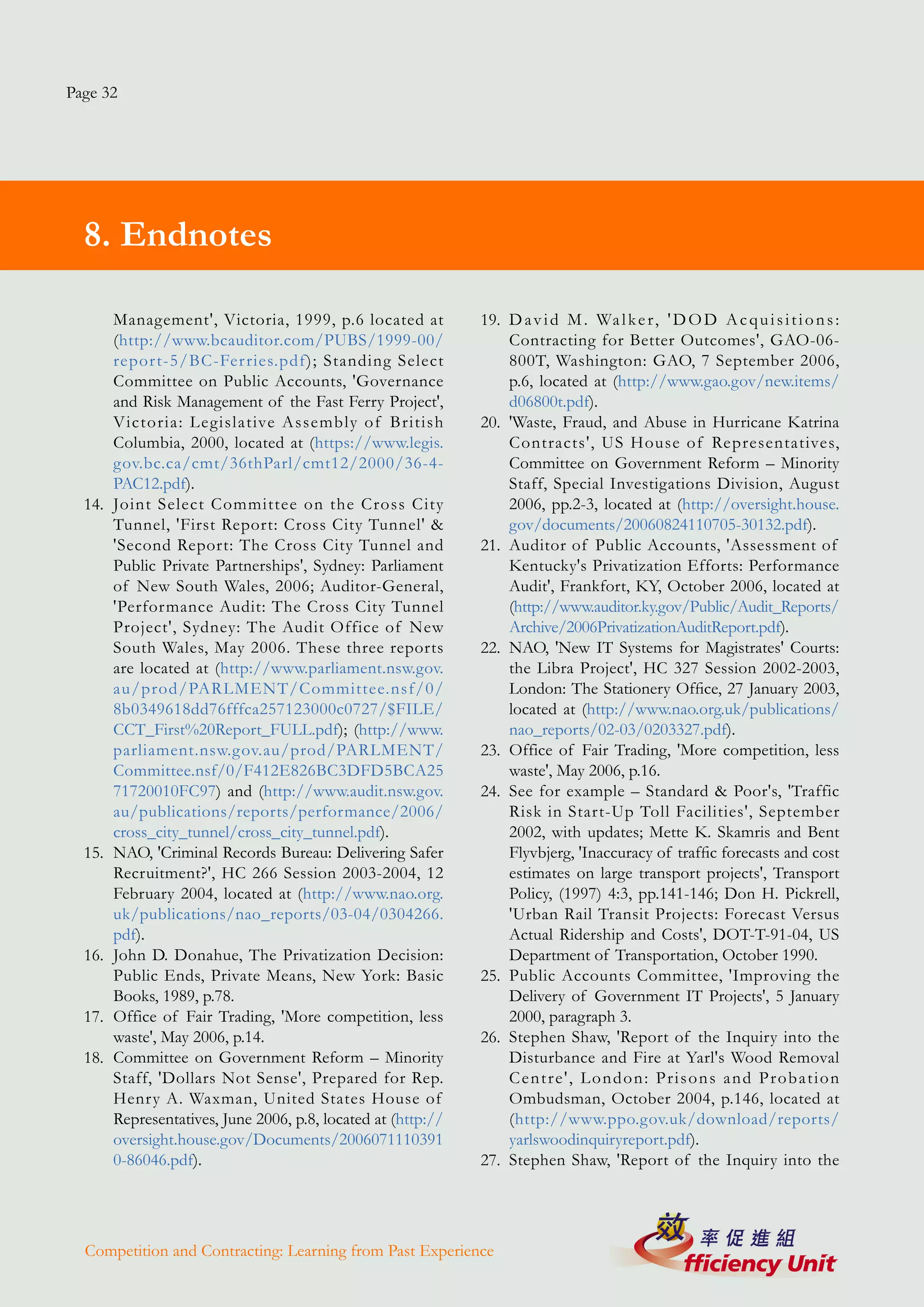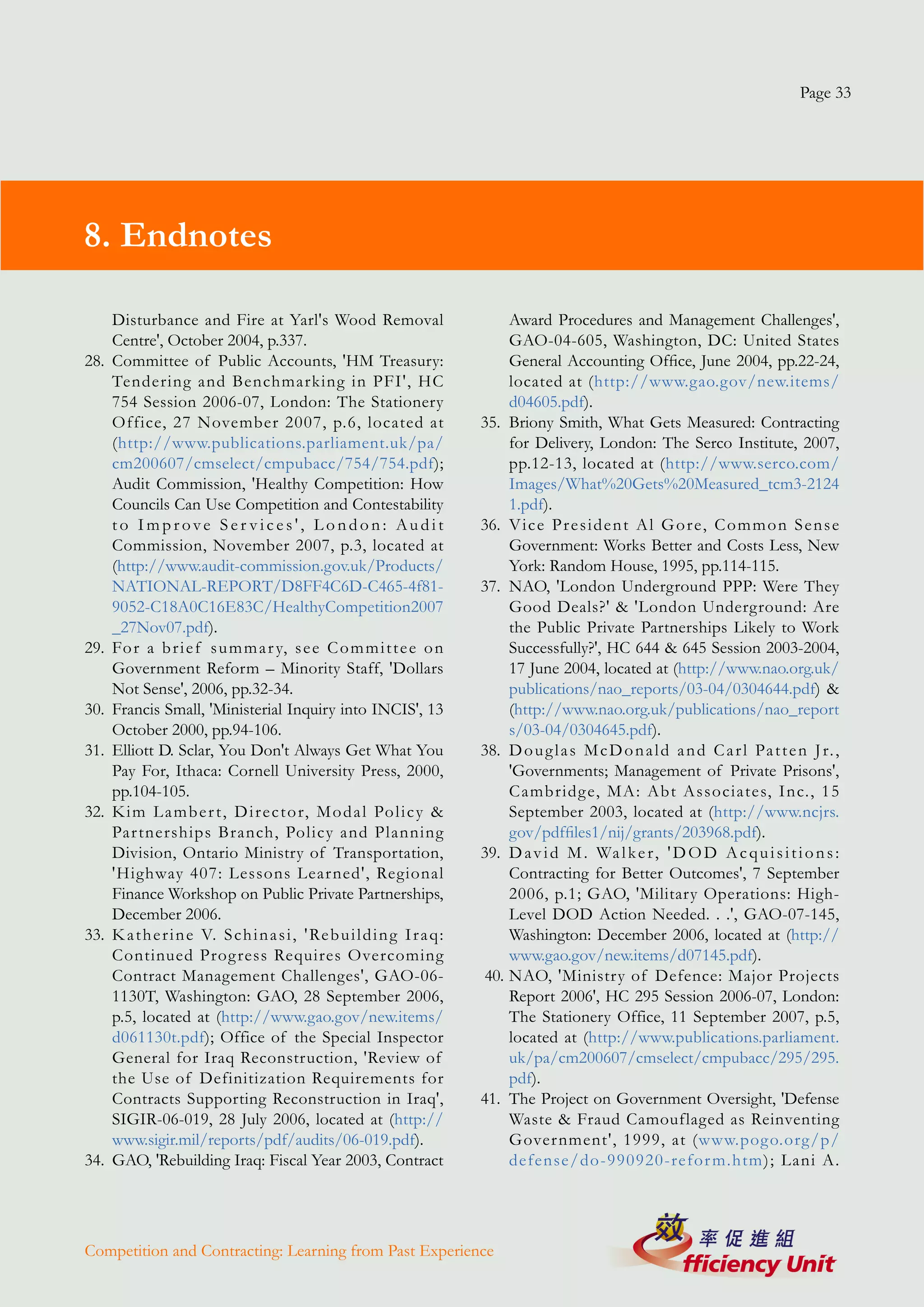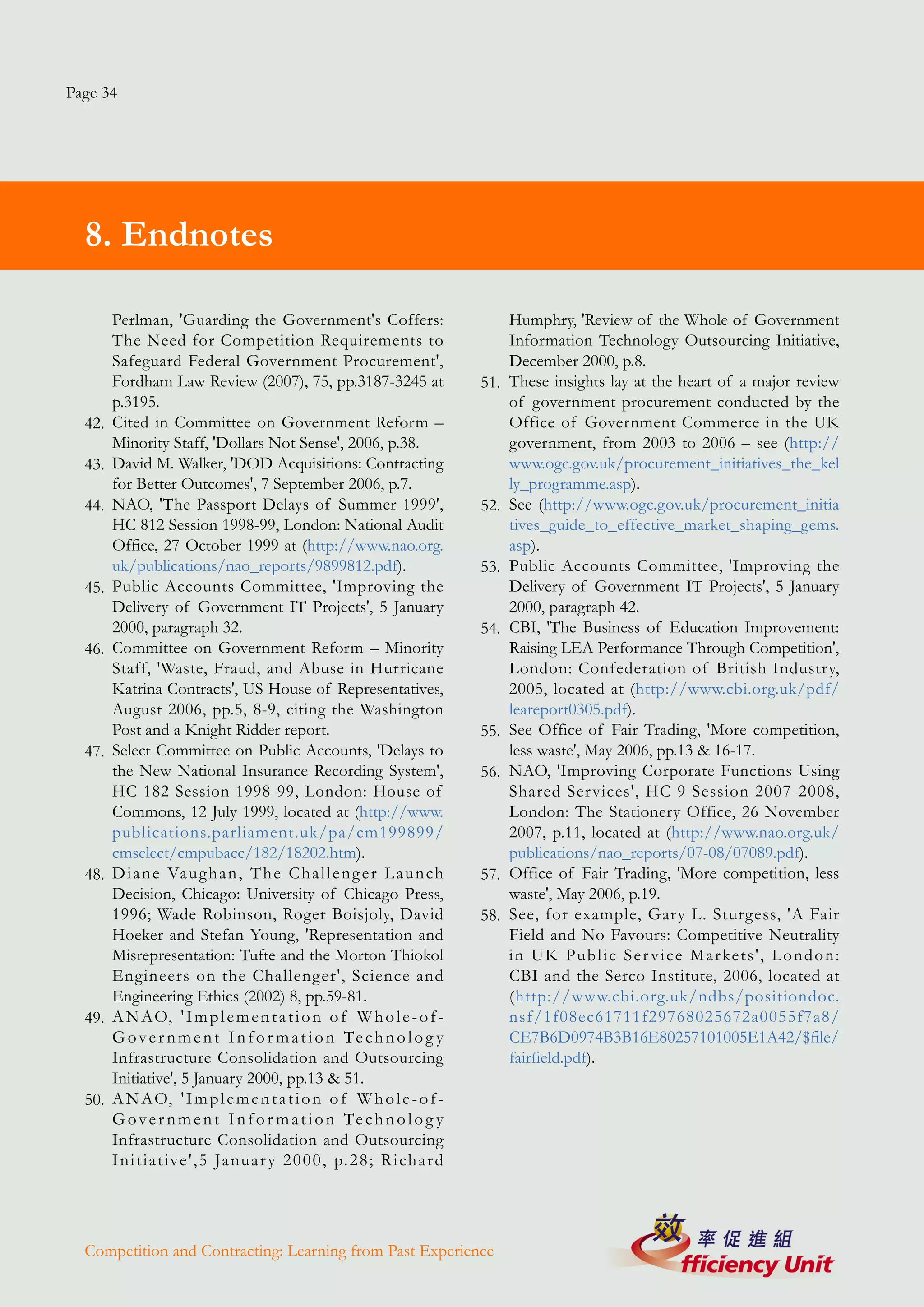Procurement design is critical to the success of government contracting. Two key case studies are highlighted:
1) Melbourne trams and trains franchises - The franchises were operationally successful but one operator withdrew after suffering $300 million in losses due to an unrealistic bid based on misunderstanding requirements and overestimating patronage. Officials were found to have generated "bid fever" where price was the sole factor.
2) National Health Service IT project - The project was beset by delays and cost overruns after requirements were poorly defined at the start. Officials failed to properly understand the scale and complexity of the project.
The lessons are that procurement officials must clearly define requirements upfront, avoid competitions solely

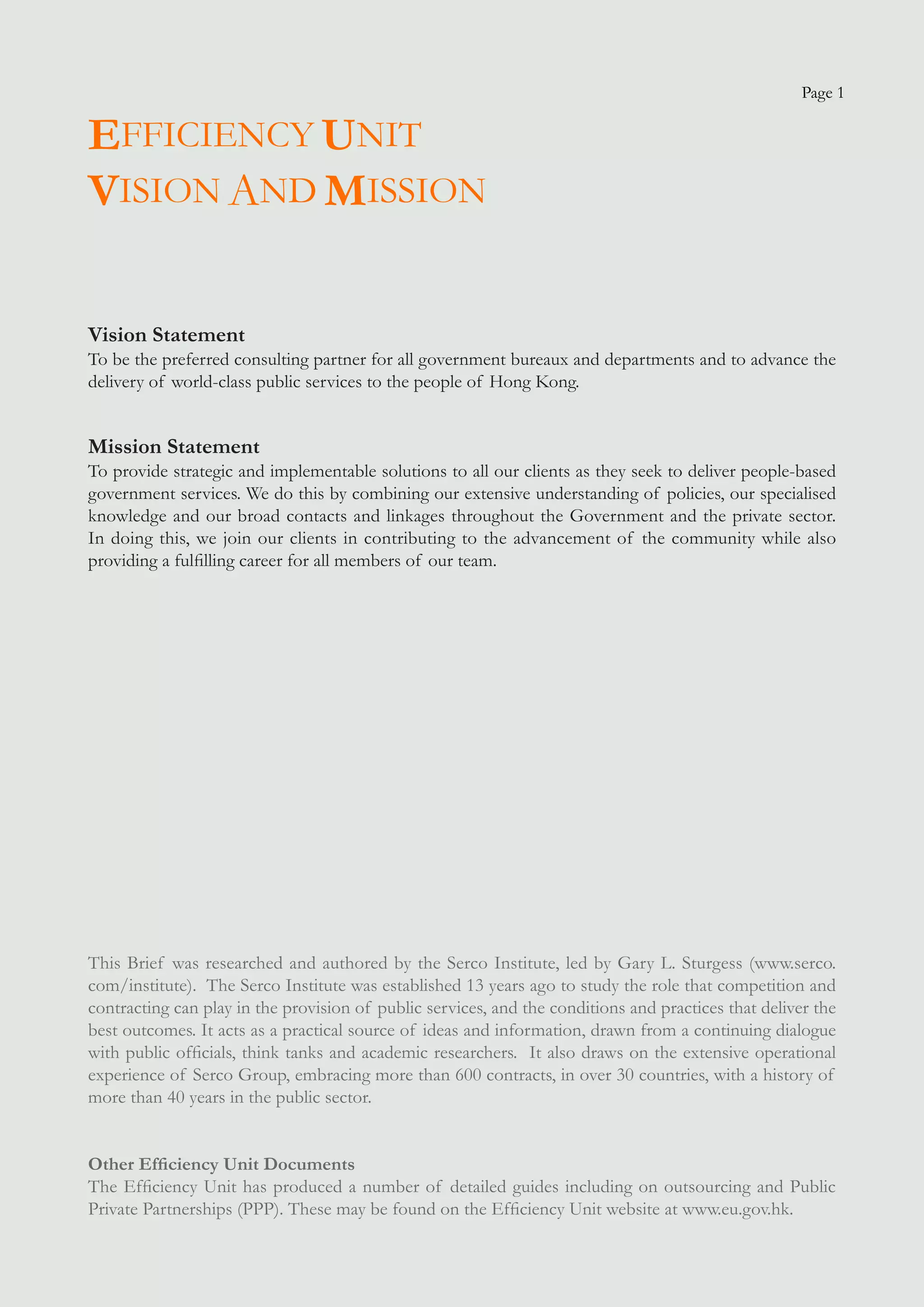

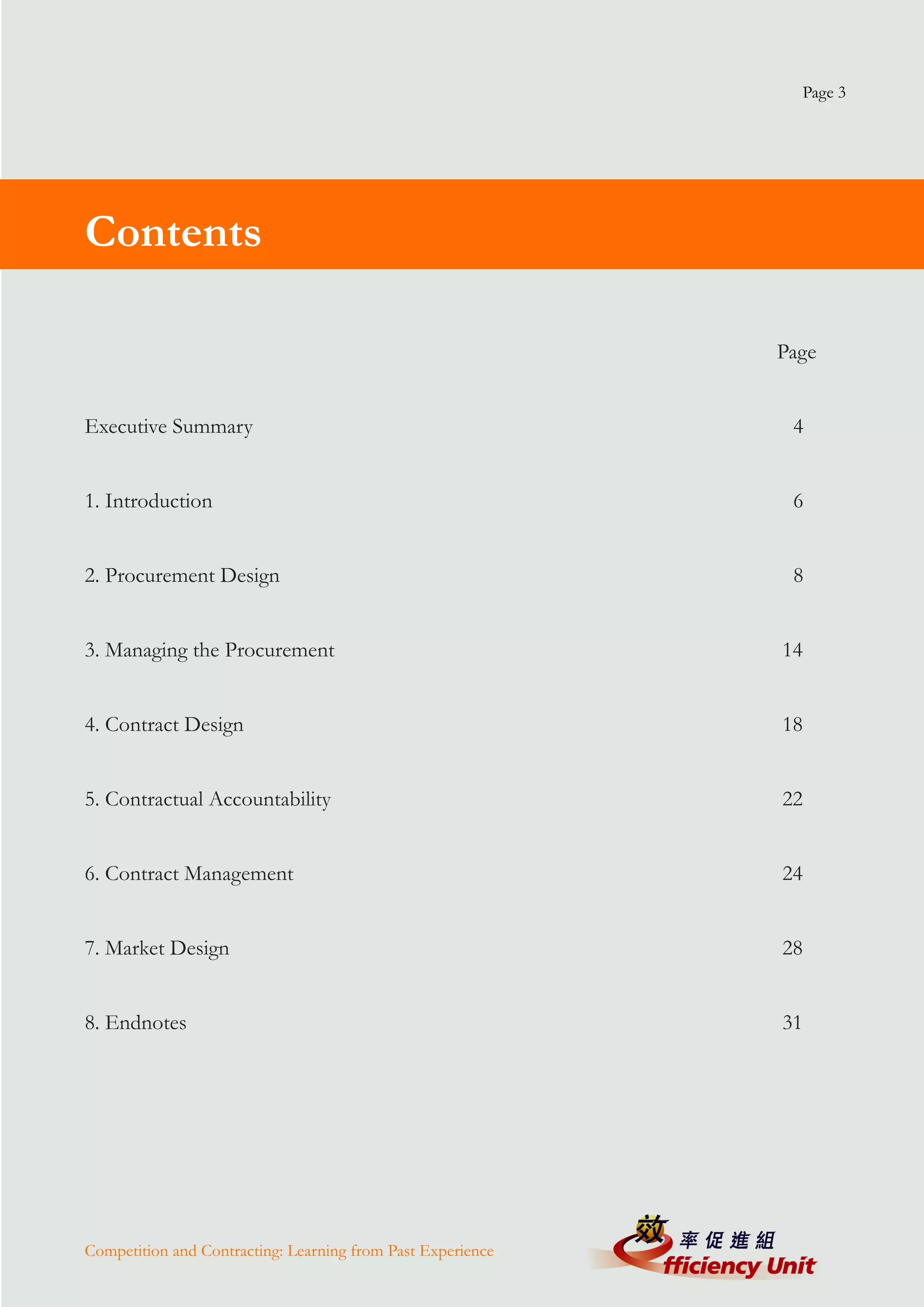
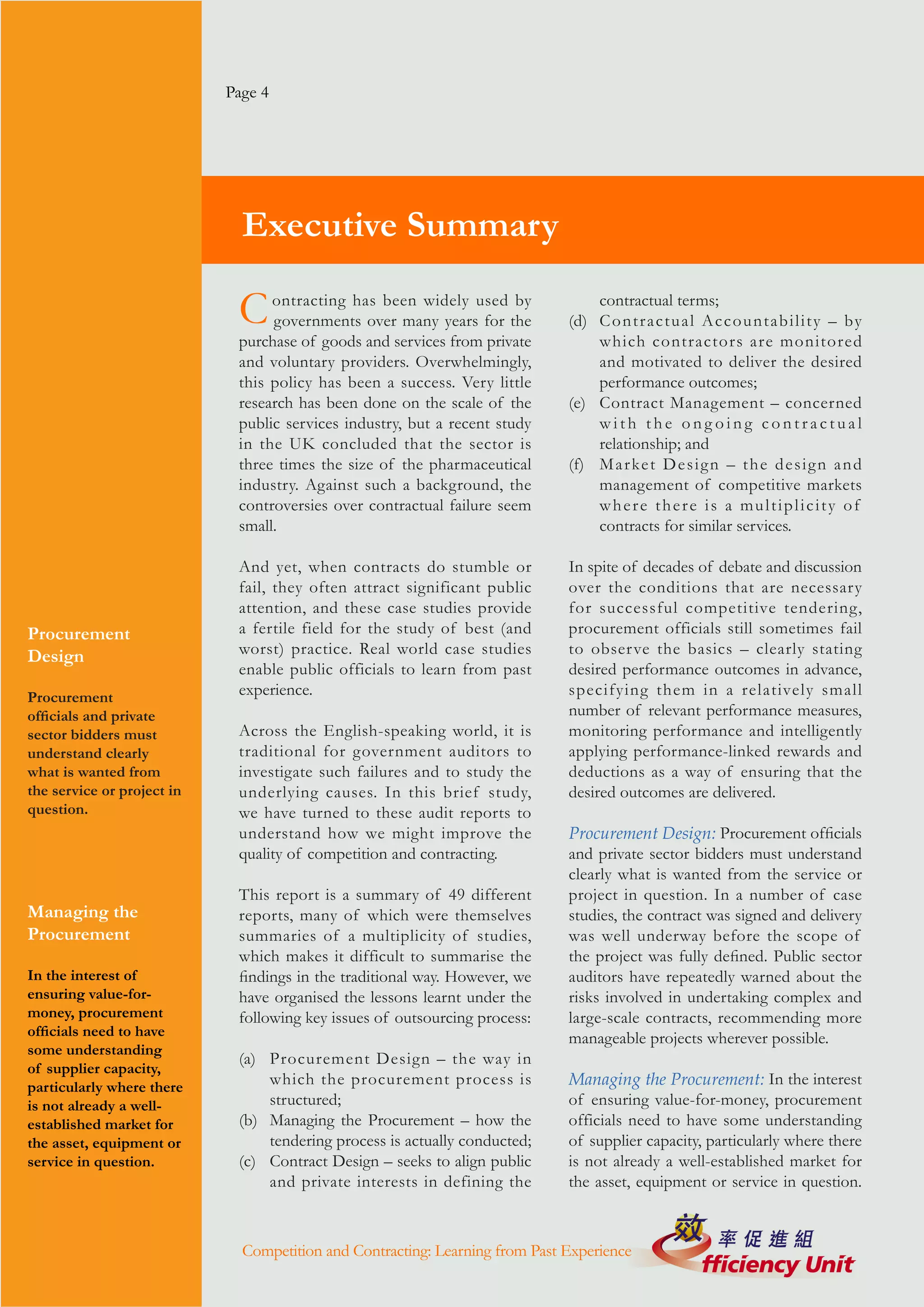

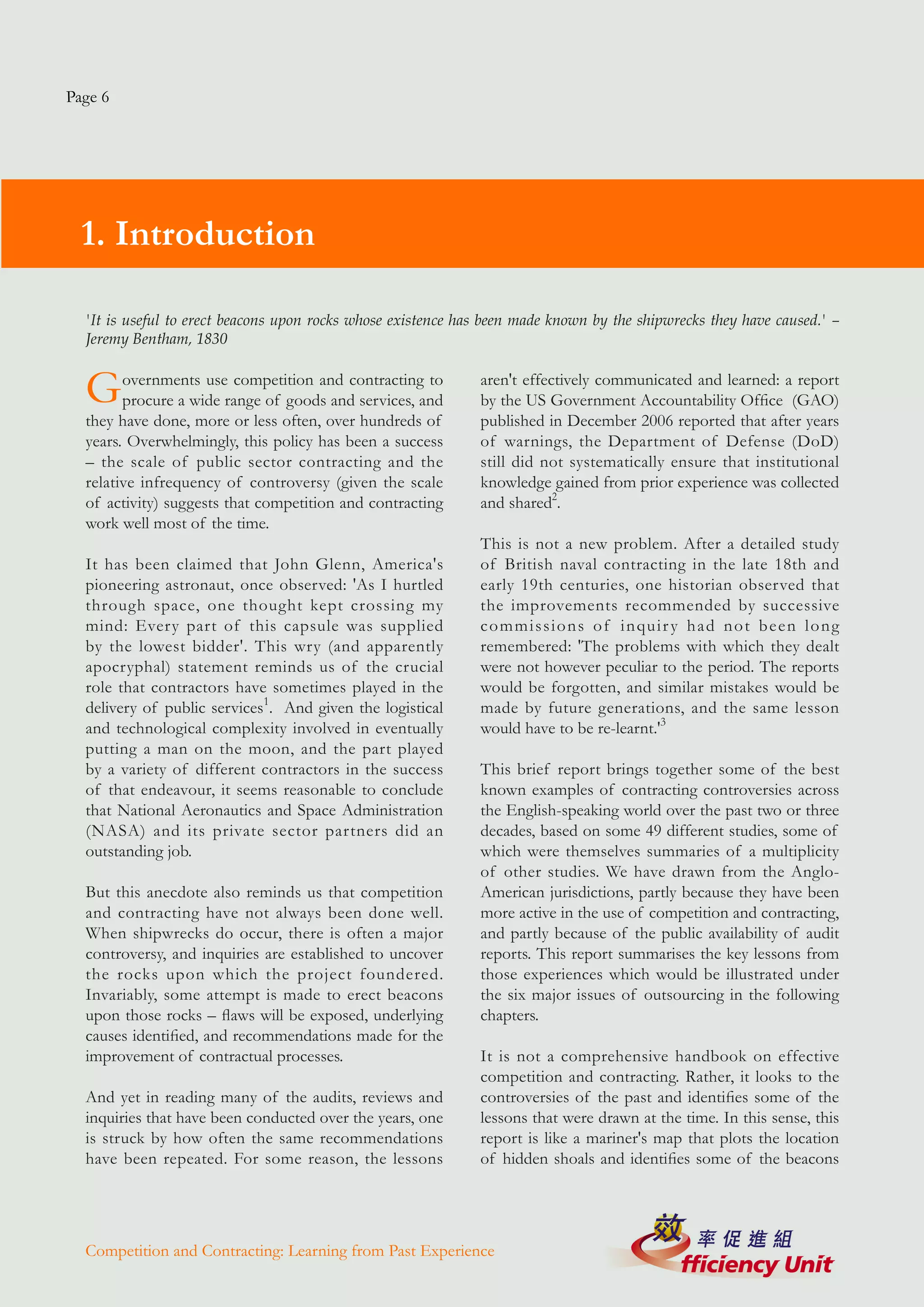
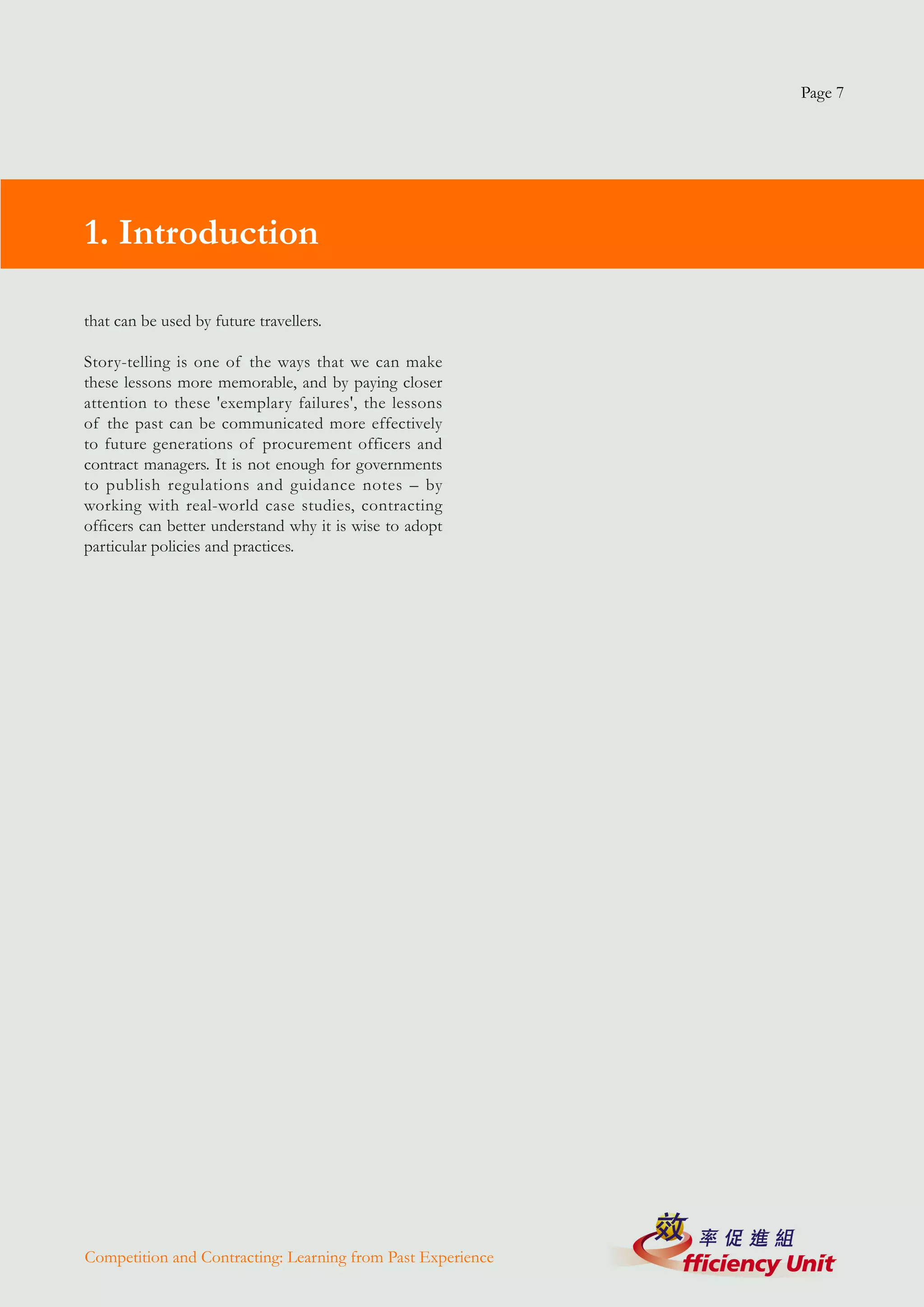
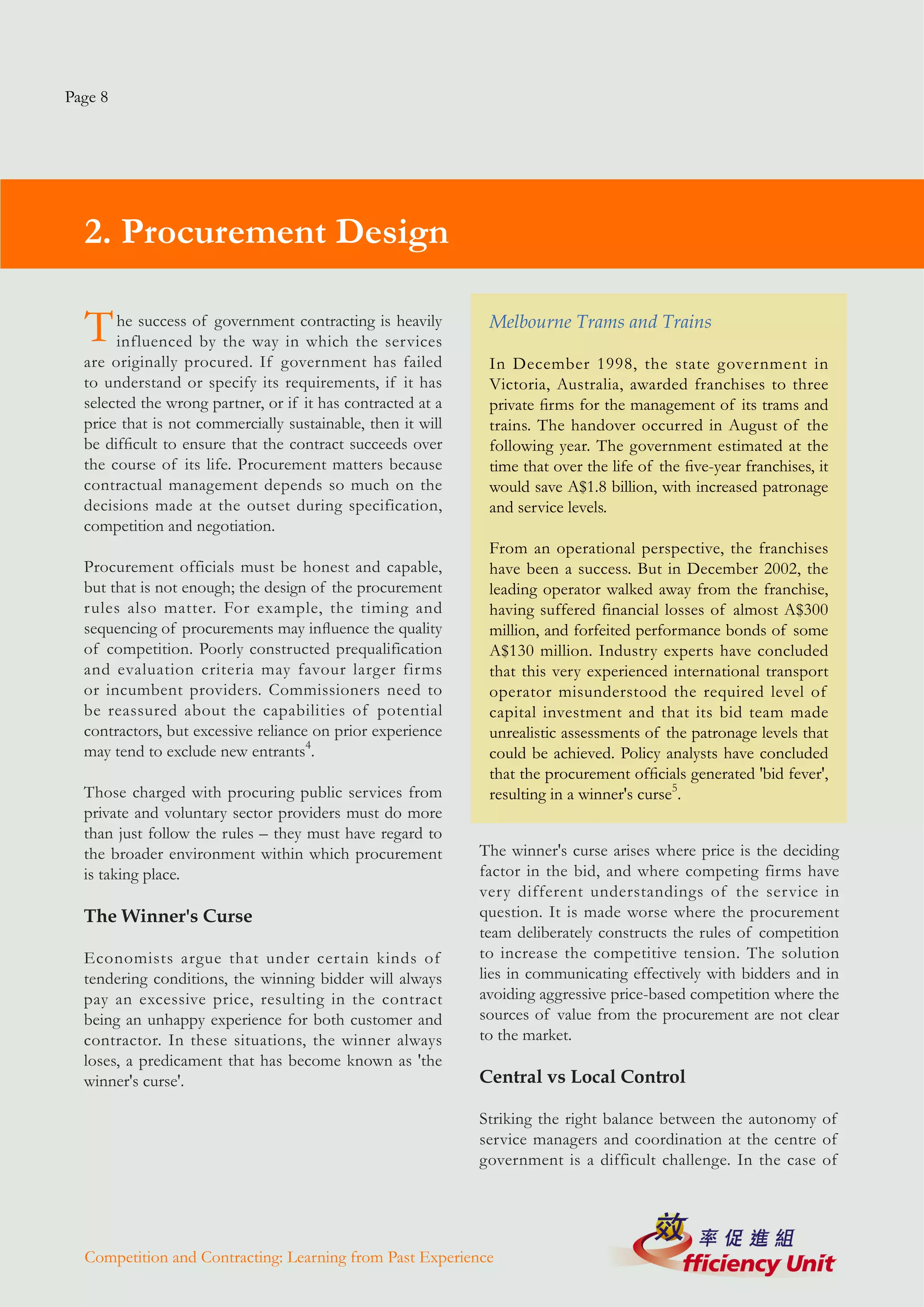
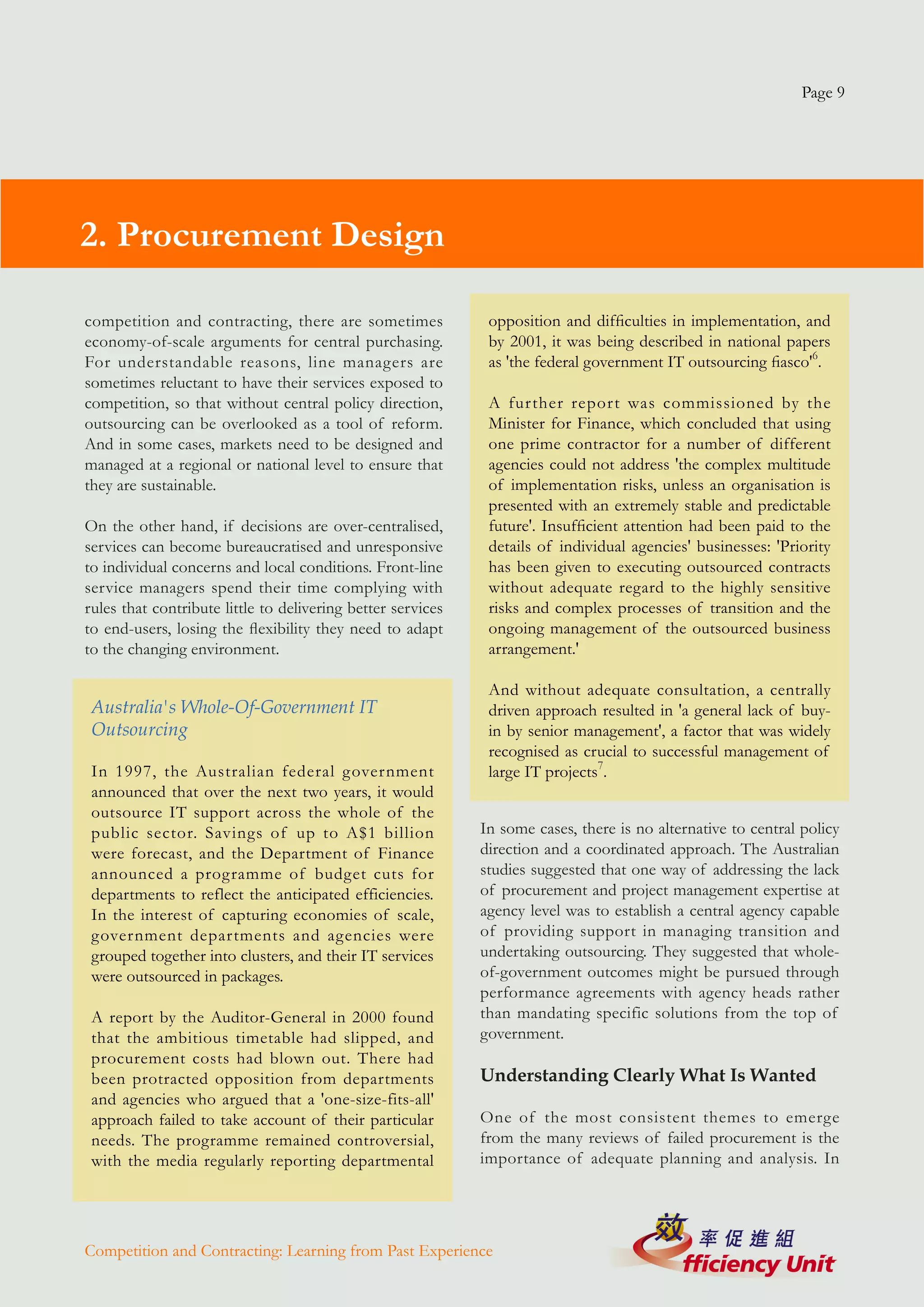
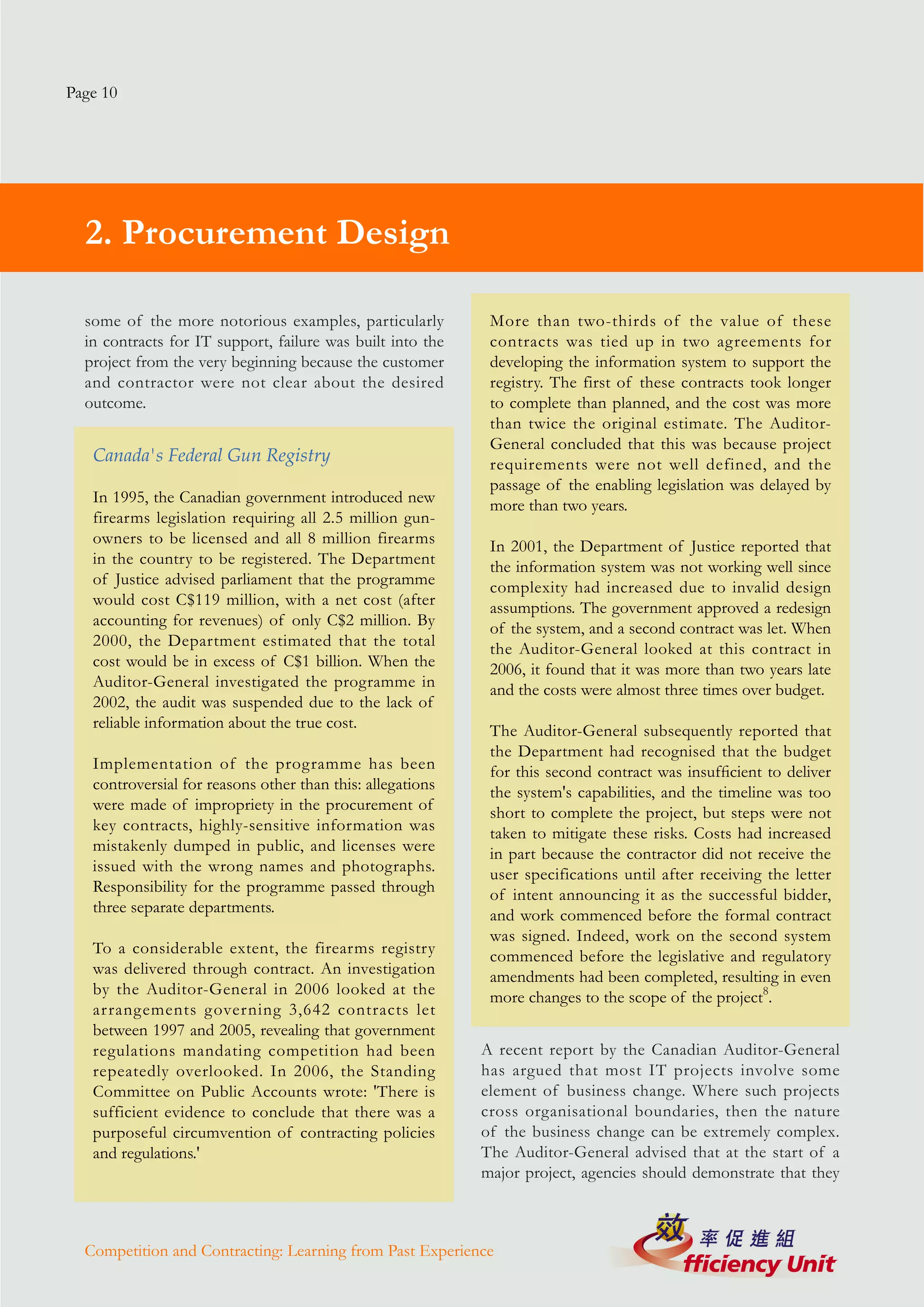
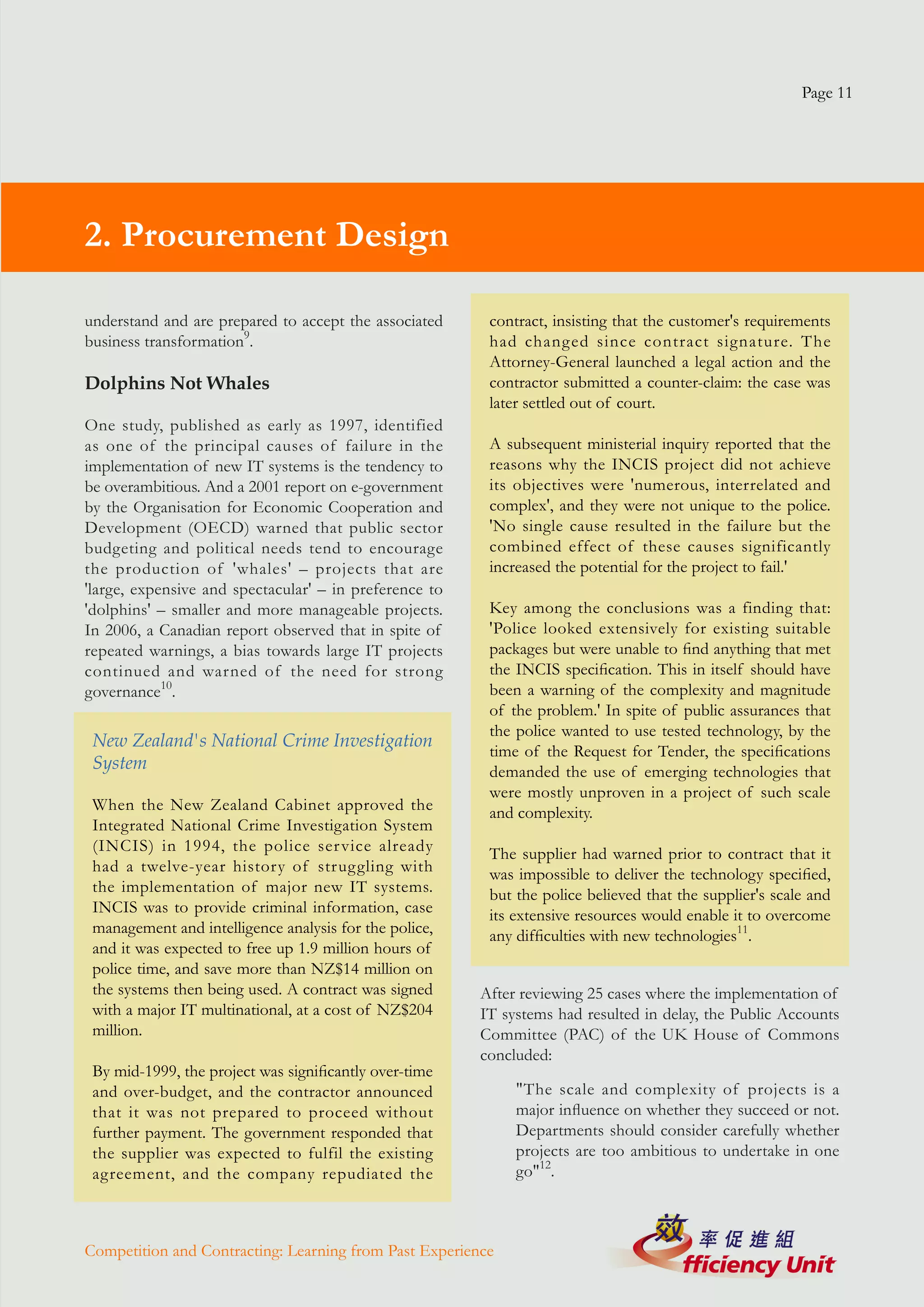
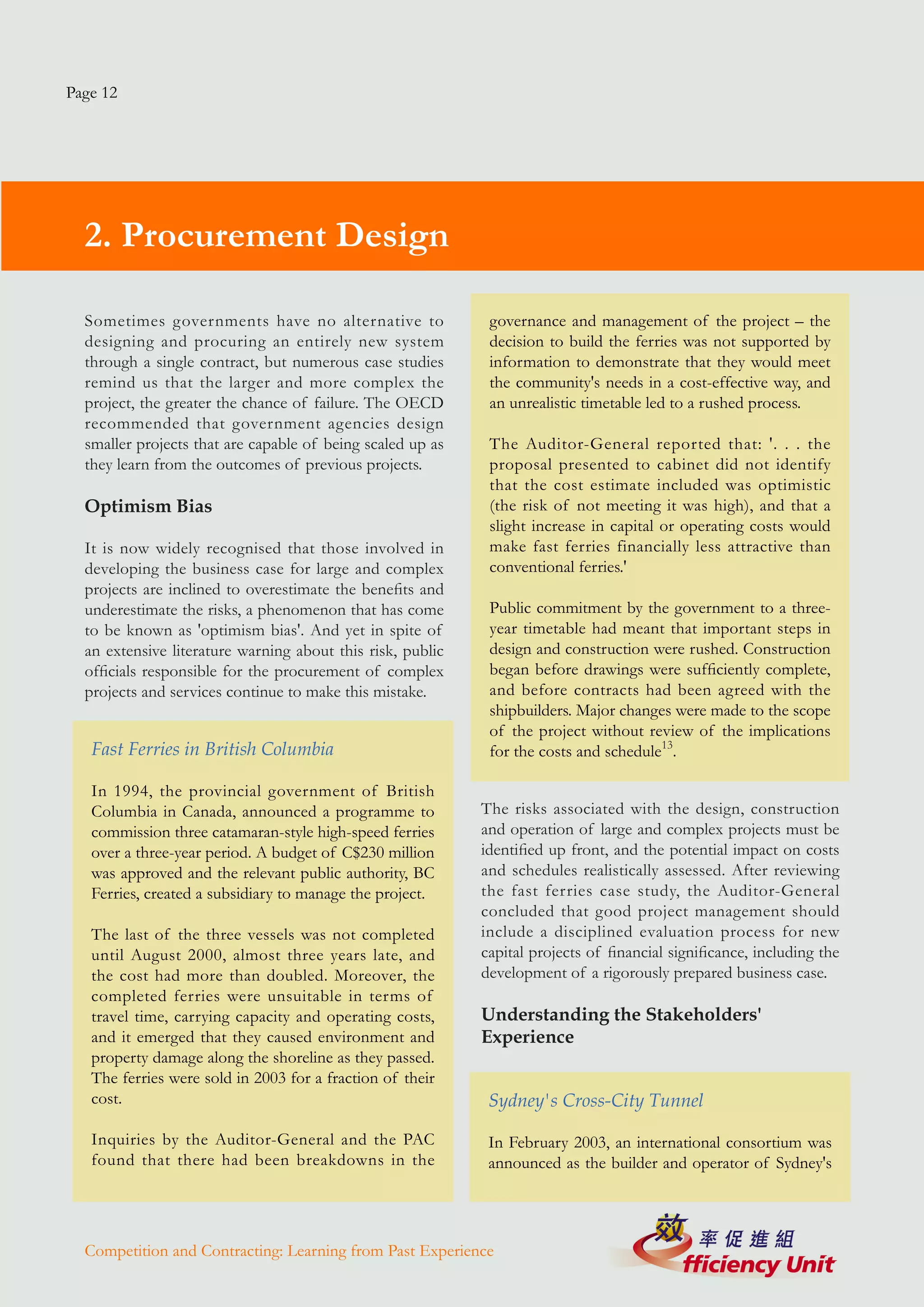
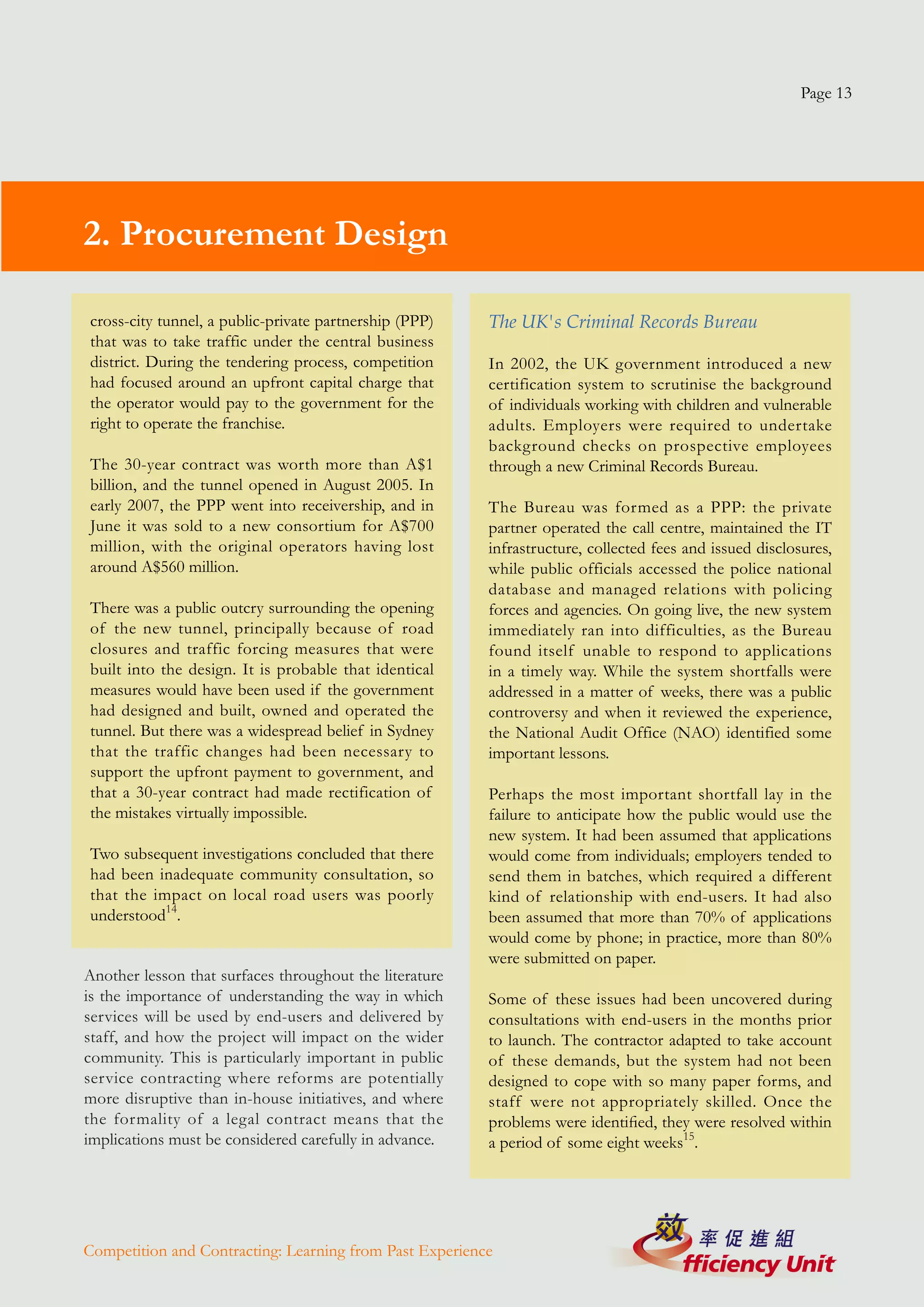
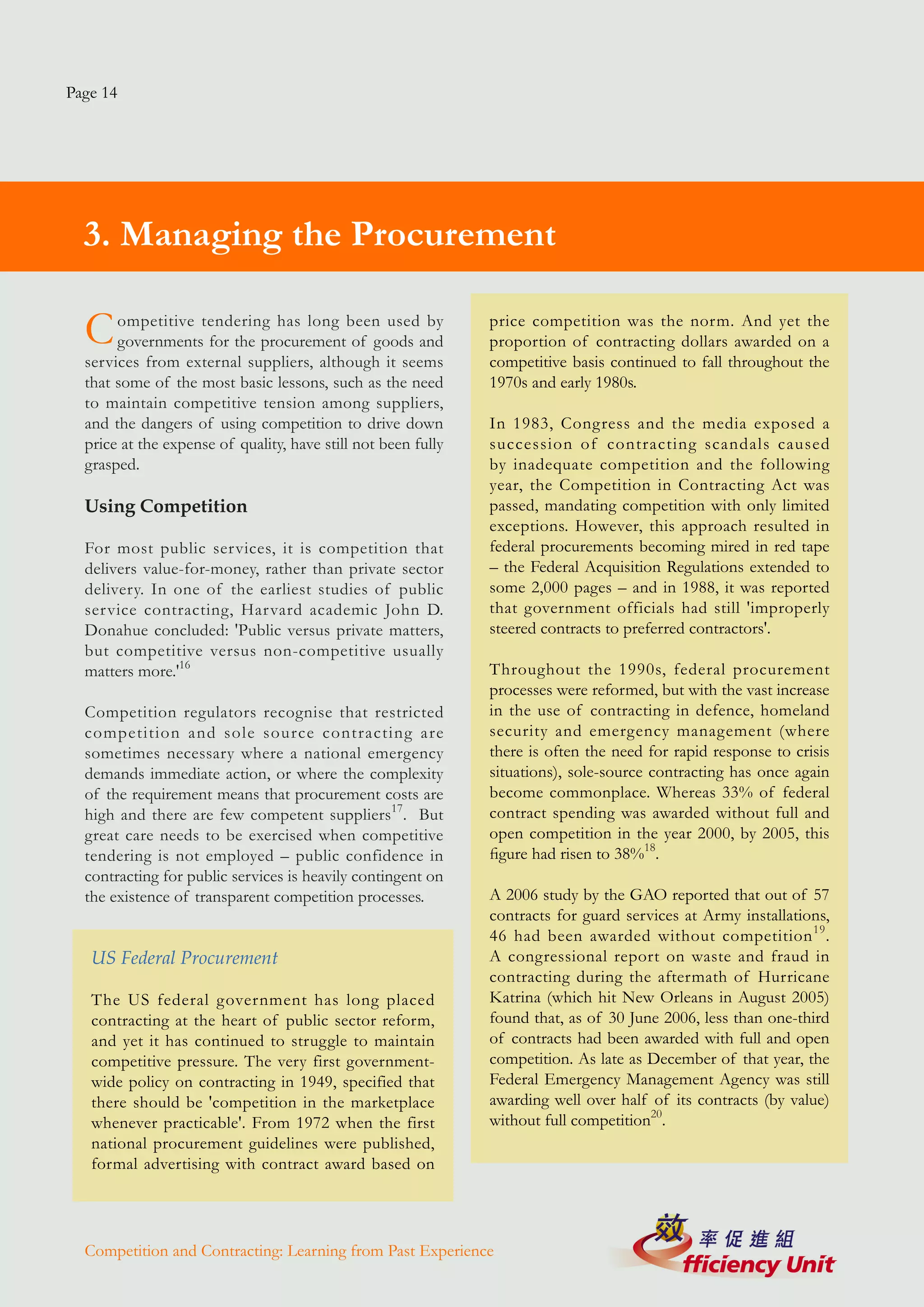
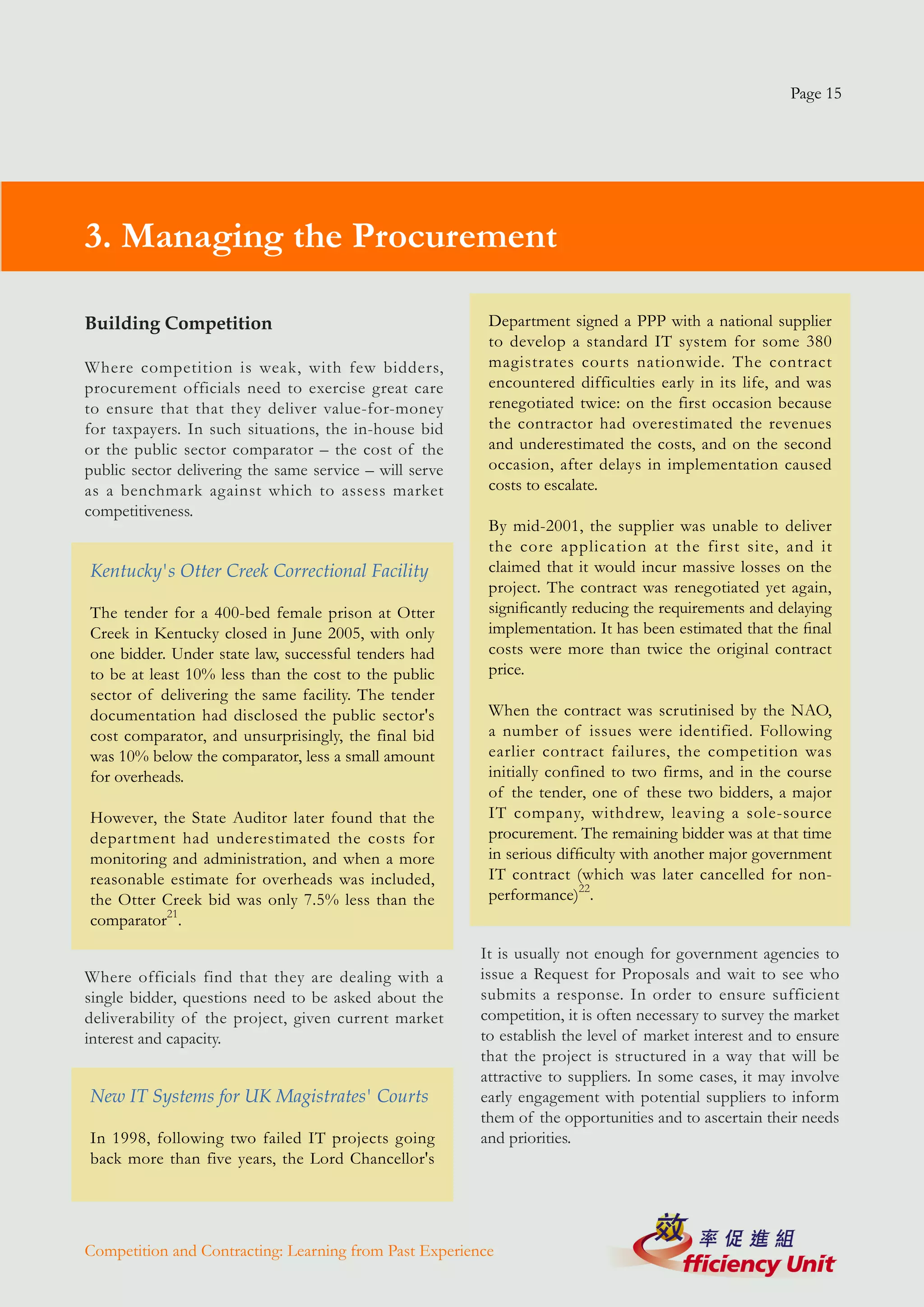
![Page 16
3. Managing the Procurement
Price-Based Tenders light. The UK PAC issued this warning about project
management: 'what seems a clear objective at the
In the UK, the Office of Fair Trading (a competition beginning can easily become blurred and confused as
regulator) has argued that: 'Even where a contract is events progress'25.
not awarded explicitly on the basis of lowest price,
bidders will form expectations about the relative Similar difficulties can emerge in the management
weight given to price compared to other criteria. of public services, where the client's demands or the
[Clients] can influence these expectations by being wider political and policy context changes without
more explicit about how they weight different adjustment to the underlying contract.
selection criteria.'23
In many cases, these problems can be avoided through
Where bidding success is largely determined by the careful planning, but with complex and long-term
willingness to assume demand risk, in effect, this will contracts, this is not always possible. Regardless of
operate very much like price-based tender, and the the cause, the financial costs of project drift can be
project may suffer from the same failing. For reasons considerable and the success of the entire service or
that are not entirely clear, franchises for the delivery project can be compromised.
of public transportation services seem particularly
vulnerable to this flaw. Successive studies over many
years have pointed to optimism bias on the part of Yarl's Wood Detention Centre
bidders in relation to traffic risk in transportation
projects. This phenomenon has been documented in The new immigration detention centre at Yarl's
relation to tollroads, bridge and tunnel projects, and Wood in England was finally opened in January
urban transit24. 2002, almost a year late. The original procurement
timetable had planned for bidders to be briefed in
late May 2000, with short-listing in early June and
Sydney's Cross-City Tunnel contract award at the end of the month. Work was
to start on-site in early July and the centre was to be
The successful consortium for this high-profile fully operational by April 2001. Some ten months
tollroad had overestimated patronage by some 200% after the facility became fully operational, there was
(yet another example of the winner's curse). Tolls a riot among the detainees, and a fire destroyed a
were widely regarded by the public in Sydney as large part of the complex.
having been set too high, and it was concluded that
this had been caused in part by the government's According to a later review by the Prison
decision to base the competitive tension around an Ombudsman, this timetable was undeliverable, and
upfront payment from bidders to government. bidders progressively dropped out, finally leaving
only one bidder remaining. The government's
advisers warned that the timetable was not
Project Drift achievable, and a subsequent review concluded,
'the speed with which things started to go wrong
It is not unusual for the client's requirements to suggests it was at best over-ambitious and at worst
change over the course of the procurement as shifts wholly ill-conceived'26.
take place in the wider political, economic and policy
environment, and as unanticipated issues come to
Competition and Contracting: Learning from Past Experience](https://image.slidesharecdn.com/learnpastexp-091020235804-phpapp02/75/Learn-Past-Exp-17-2048.jpg)
![Page 17
3. Managing the Procurement
One of the consequences of accelerated delivery in November 2007 by the PAC of the House of
was a decision to construct the facility out of wood Commons concluded that 'One-third of procuring
rather than concrete, and some of the interior authorities admit that they have insufficient resources
walls were described as flimsy. If the facility had or in-house expertise for part or all of the. . .
been used as originally intended, this might not tendering process [for PPPs].'
have mattered, but shortly after opening, a decision
was made to transfer in detainees with a criminal The same week, a report by the Audit Commission on
background, some of whom had been involved competition and contestability in local public services
in disturbances at previous centres. The Prison reported that 'councils generally lack sufficient people
Ombudsman later concluded that the change with the procurement, risk or contract management
was implemented too quickly, with a lack of skills to make effective use of market mechanisms'28.
discrimination and with insufficient attention to the In the US, a succession of reports has commented
likely consequences. on the lack of qualified programme managers,
most notably in the Departments of Defense and
Some claimed that this shift occurred as the result Homeland Security29.
of a sudden change in policy, driven by a political
timetable designed to relieve pressure on the
prisons. The Prison Ombudsman concluded that New Zealand's National Crime Investigation
while the shift in policy had not been driven by System
Ministers, officials may well have misconstrued their
intentions27. The factual details of this failed IT project have
been outlined on Page 11. One of the many reasons
for failure was the refusal to appoint an experienced
The use of fixed-price contracts involving significant project manager to oversee this large, complex and
risk transfer (such as those typically used in PPPs) unique contract. The police department had insisted
has sometimes helped to focus the parties' attention that a sworn police office be chosen as Project
on such questions up front. On the other hand, the Director, and in spite of strong policing credentials,
legal formality of contractual arrangements involving he lacked experience in managing such a complex
significant risk transfer may make contractual refresh project. Moreover, his place in the command-line
to take account of environmental change more culture in policing made open and frank reporting
difficult. of emerging problems difficult30.
Many of the inquiries into failed and challenged
contracts have addressed this question. The solutions
lie in strong governance and management frameworks
– clear ownership, good communication and periodic
review.
Contracting Capabilities
Perhaps the most common of findings in contracting
reviews is a lack of capability on the part of
procurement officers. In the UK, a report published
Competition and Contracting: Learning from Past Experience](https://image.slidesharecdn.com/learnpastexp-091020235804-phpapp02/75/Learn-Past-Exp-18-2048.jpg)
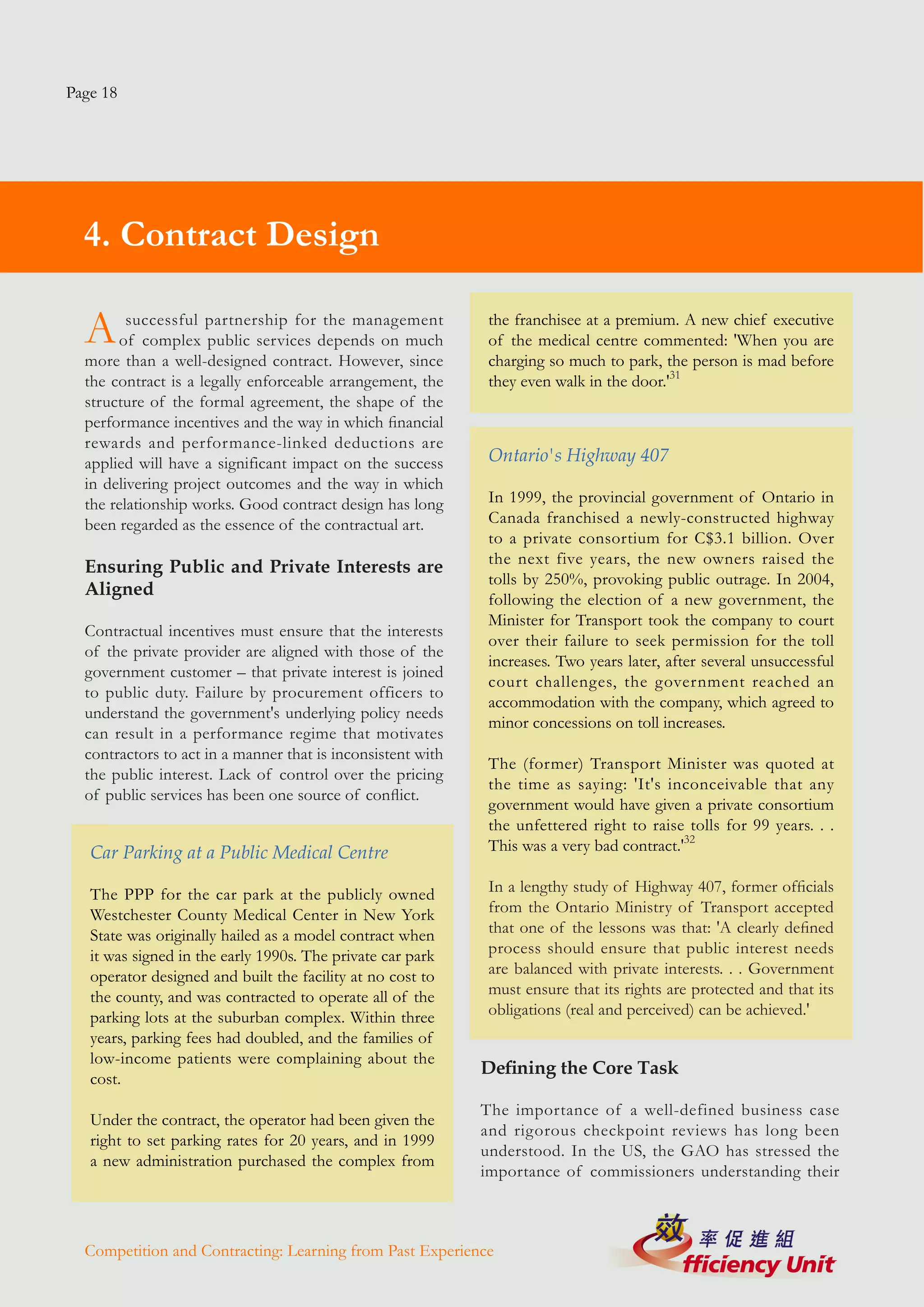
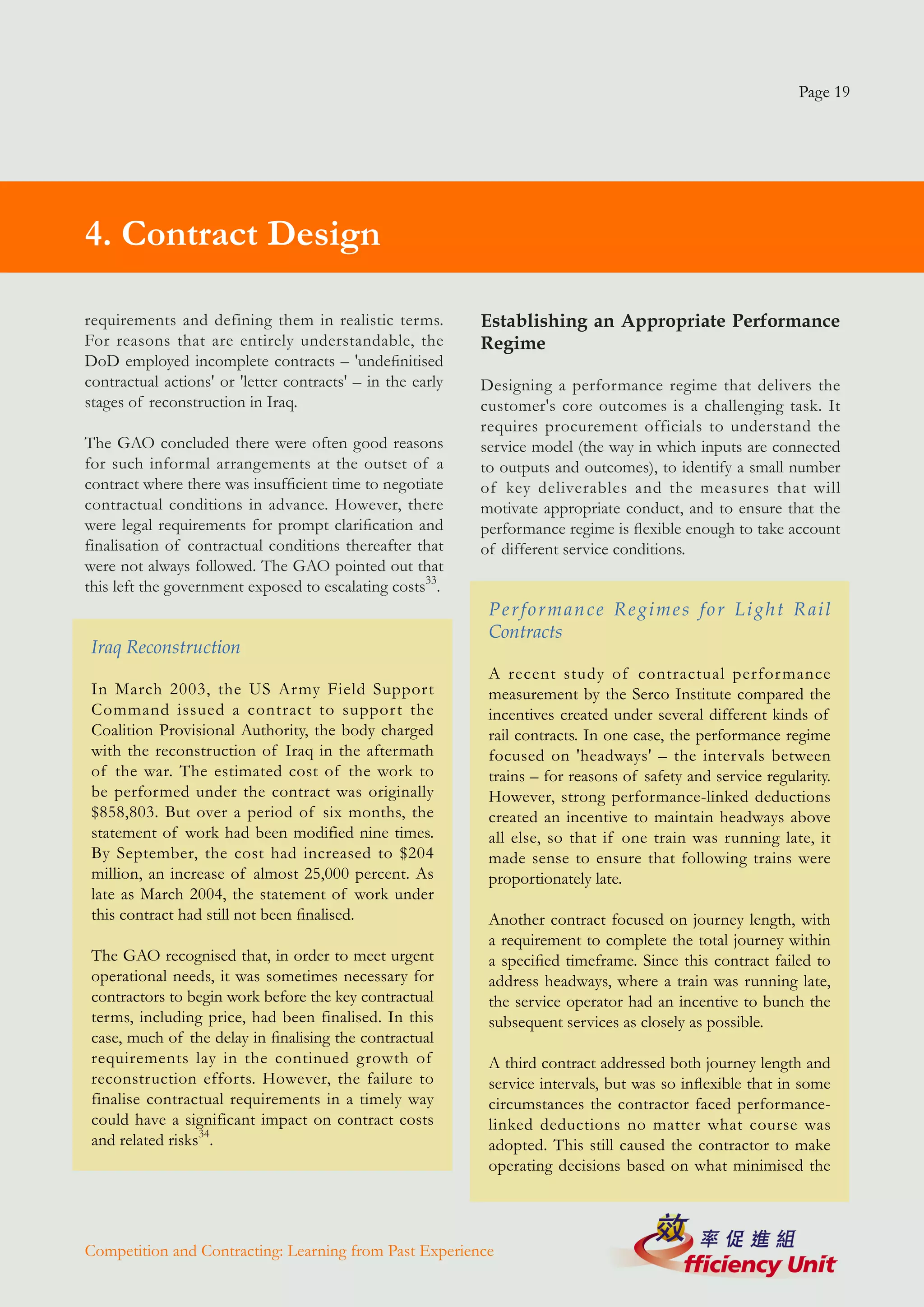


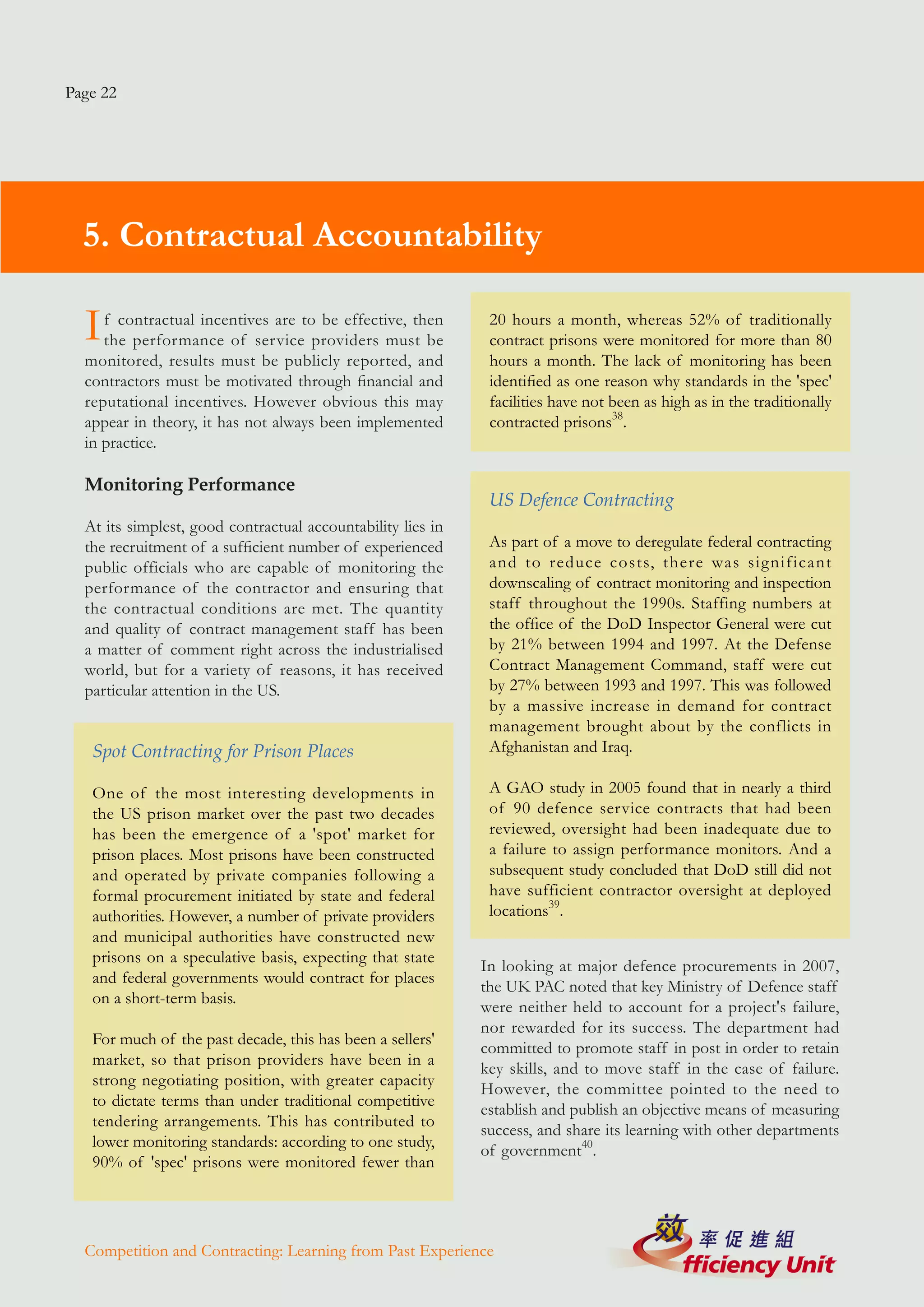


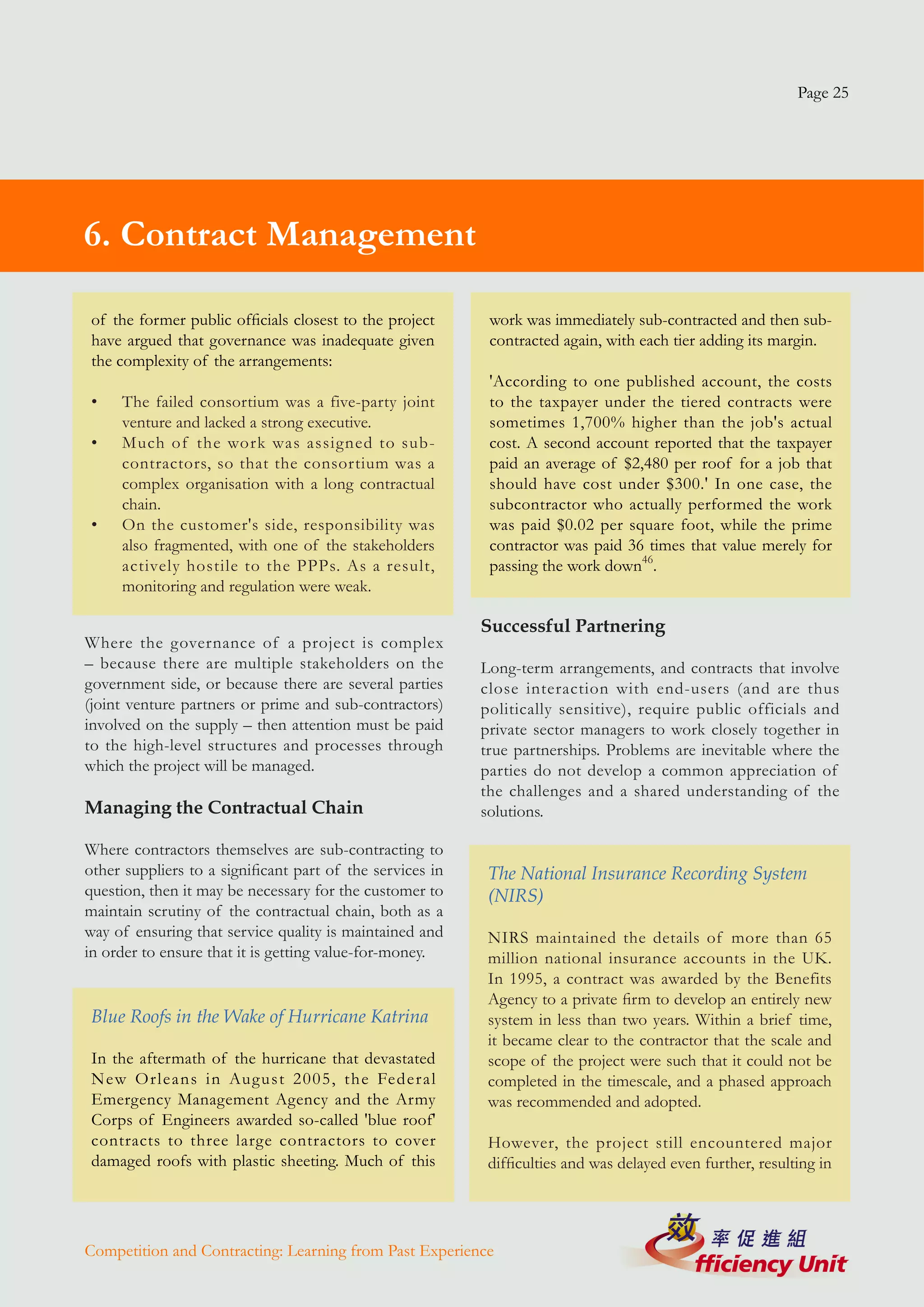
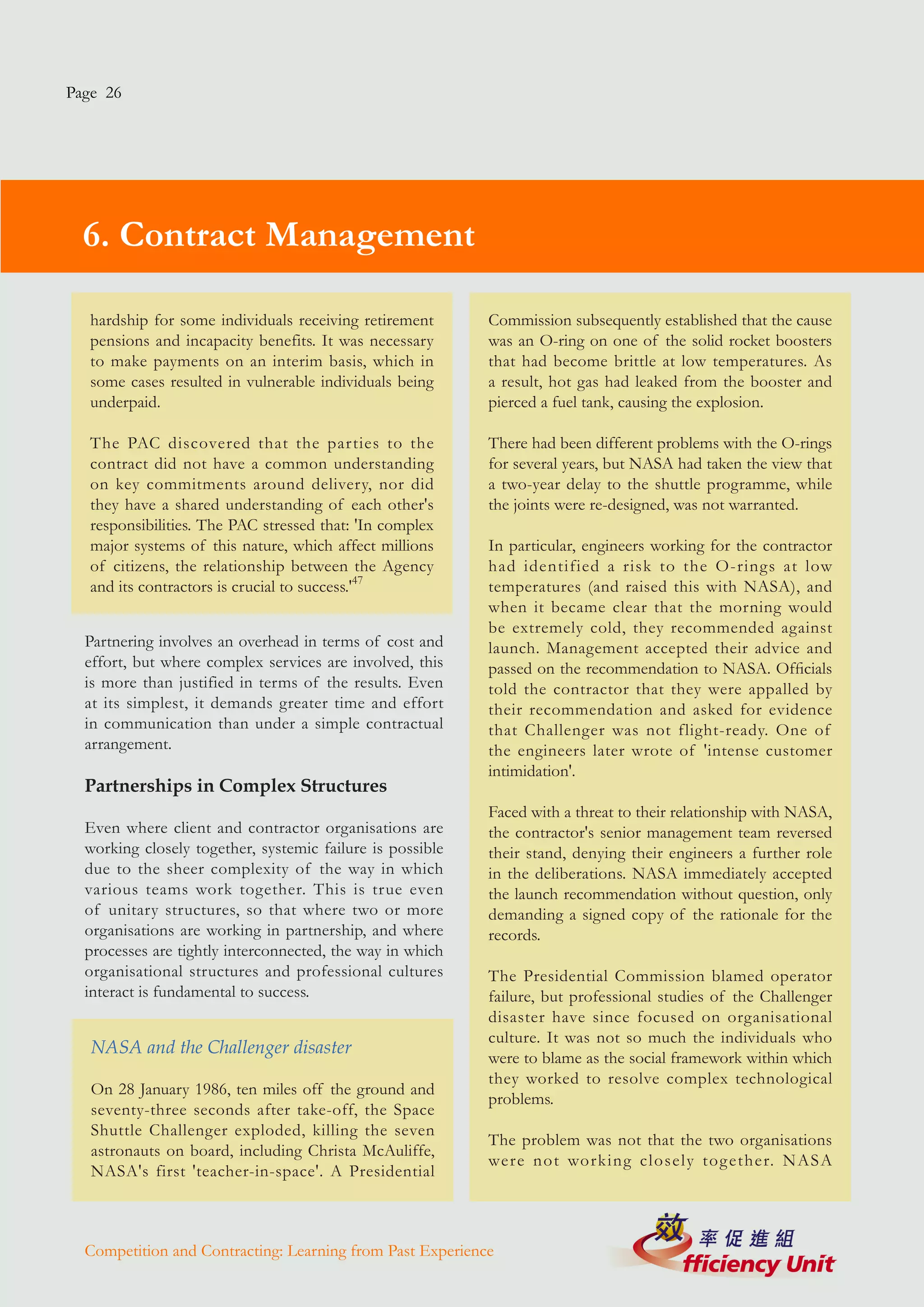
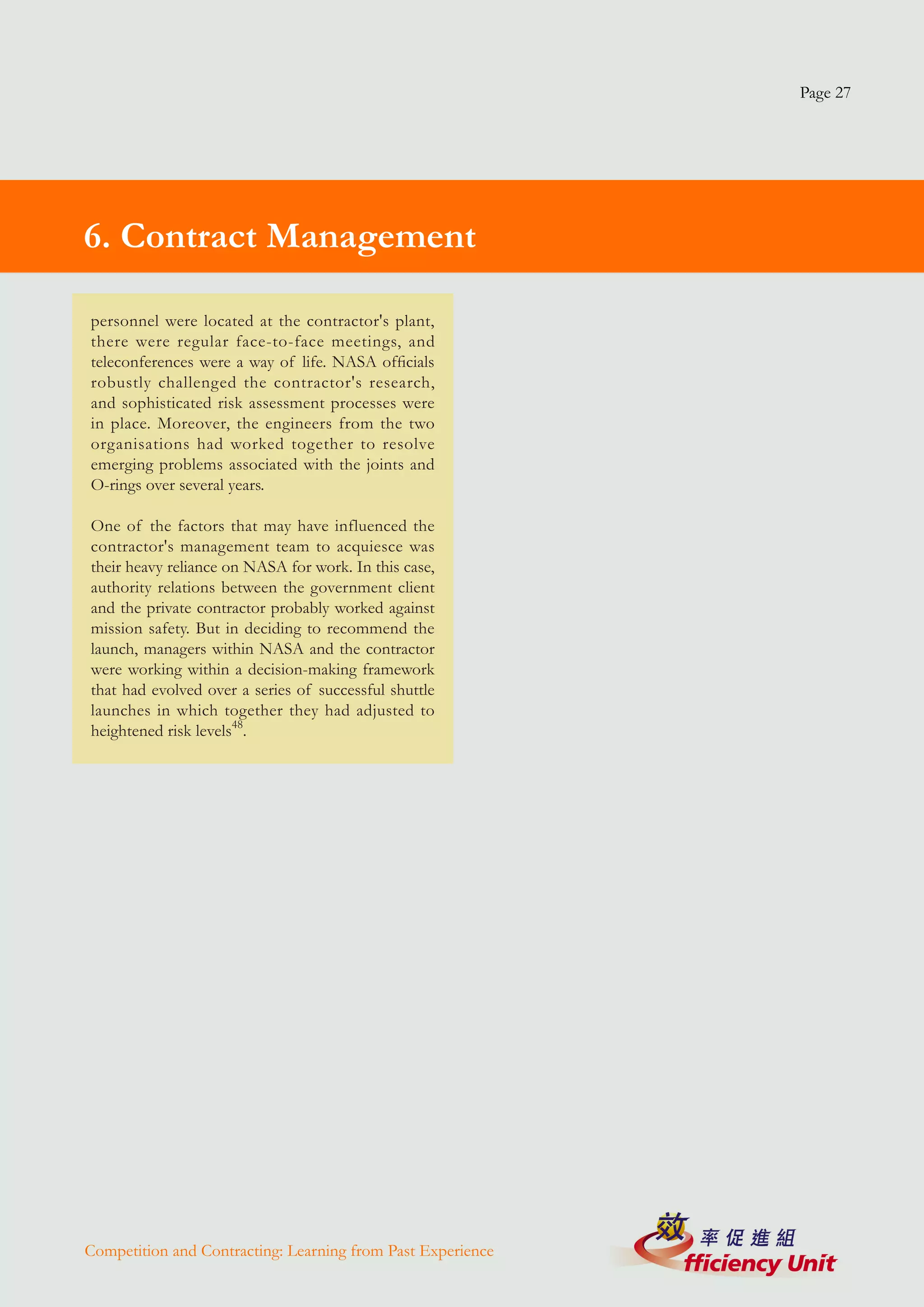
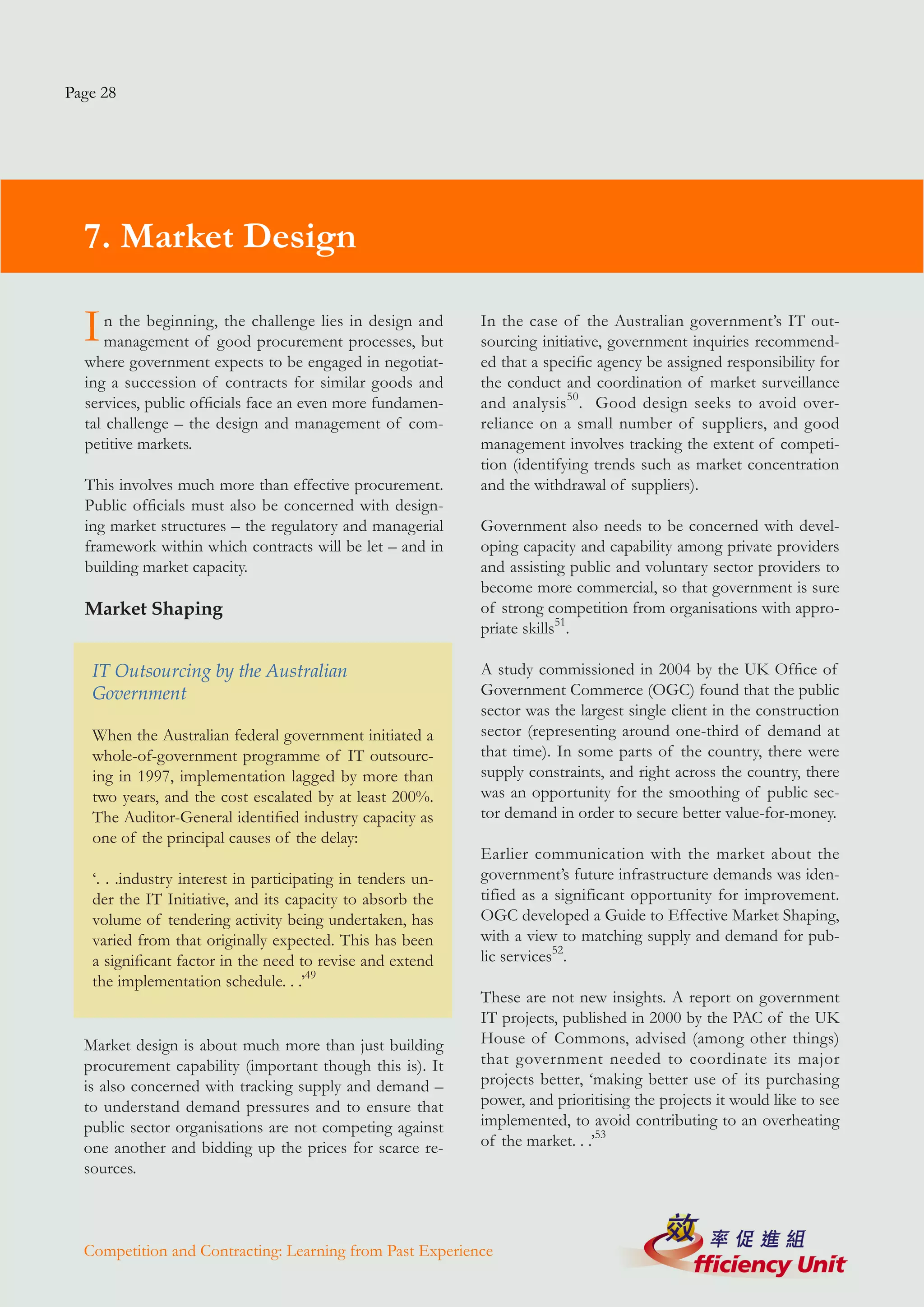
![Page 29
7. Market Design
Market Depth to ensure competitive procurement. Large contracts
tend to favour incumbents. On the other hand, small-
er contracts make it easier for new firms to enter the
The UK Market for Managing Local market, thereby deepening competition. (However,
Education Authorities contracts also have to be large enough to justify in-
vestment in bidding and in the improvement of physi-
Legislation passed in 1998 gave the UK Education cal infrastructure and the retraining of people.)
Secretary power to intervene in local education
authorities (LEAs) that were deemed to be Officials also need to consider deal flow – companies
failing. Ofsted, the education standards authority, will make deeper investments in capability and sup-
subsequently identified around 20 LEAs that were pliers will be more responsive to the client’s ongoing
failing and had not been able to turn around their demands if they are aware of a stream of future op-
performance. Eleven of these were reformed portunities55.
through internal intervention, while the other nine
were exposed to market-testing. Fair Markets
Companies were encouraged to invest in this Companies will not invest in public service markets –
emerging market, and there was an expectation and governments will not ensure value-for-money – if
that if these pilot projects proved to be successful, market rules are biased in favour of particular kinds
then further opportunities would follow. These of provider. This is most often a problem when pub-
companies assumed financial risks and invested lic sector organisations are competing in the market,
in new capabilities, expecting that they would be because of the lack of transparency around the costs
written off over a succession of future projects. of production and the traditional advantages enjoyed
by public sector monopolies.
Research has shown that student performance at
the privately managed LEAs improved more than
the national average, and by more than the 11 Taxation of Public Service Providers
LEAs that were exposed to internal intervention.
However, for the most part, the contracts have not A recent report by the NAO in the UK on
been renewed as they have expired, and only one or the market for corporate shared ser vices in
two authorities have entered into new partnerships government concluded with a warning that 'for
with the private sector. A subsequent study by some organisations, buying shared services incurs
the Confederation of British Industry – the peak irrecoverable VAT [a goods and services tax].
industry association in the UK – argued that the This provides a potential disincentive to moving
education department needed to acquire intelligence to shared services.' Indeed, the UK rules on the
and skills to engage in market development54. taxation of business enterprises are so complex,
that in higher education, the tax advantages can flip
between the public and private sectors depending
In the interest of building deeper markets, public of- on whether training is provided to an individual or a
ficials must also make decisions about contract size business56.
and contract length – a small number of very large
contracts will thin out the market and make it harder
Competition and Contracting: Learning from Past Experience](https://image.slidesharecdn.com/learnpastexp-091020235804-phpapp02/75/Learn-Past-Exp-30-2048.jpg)
